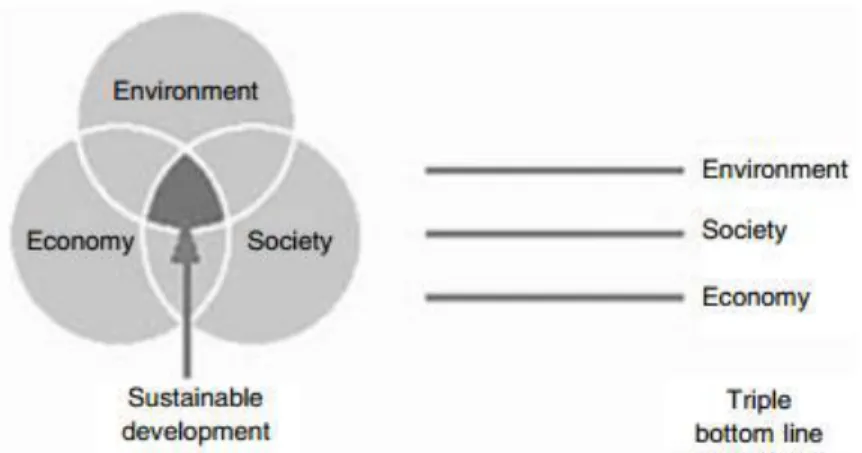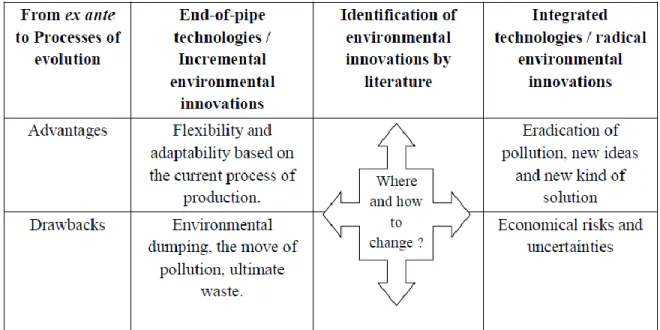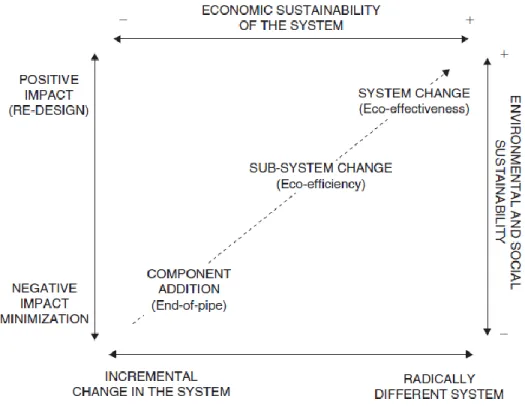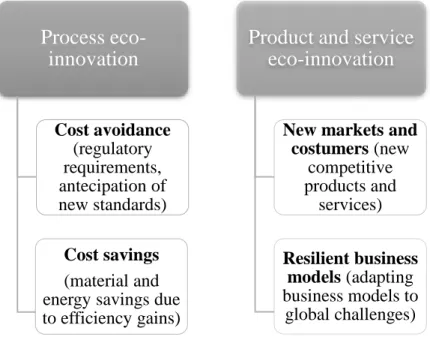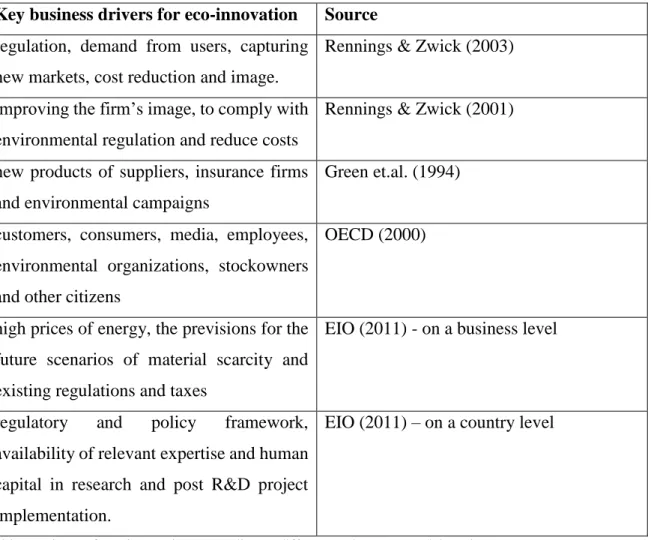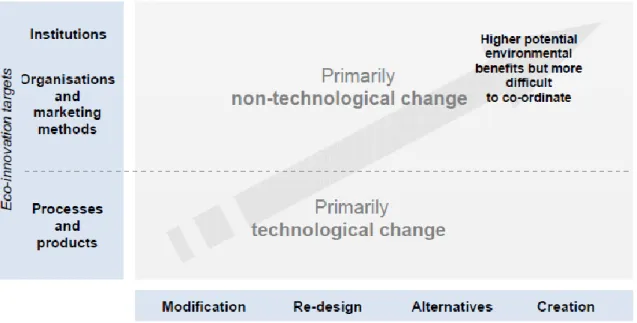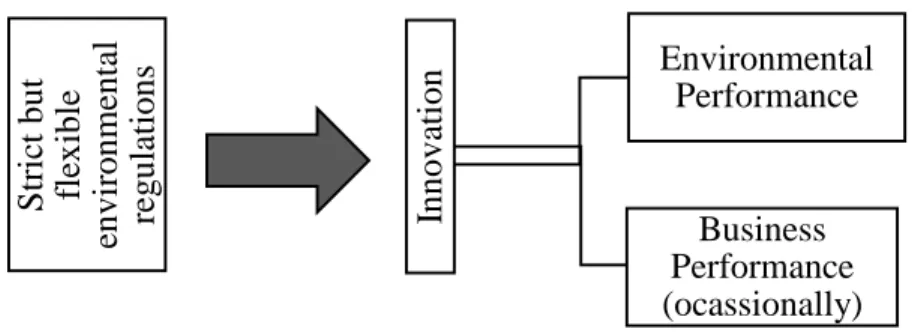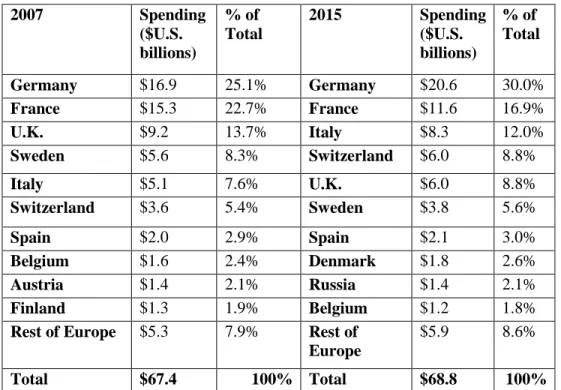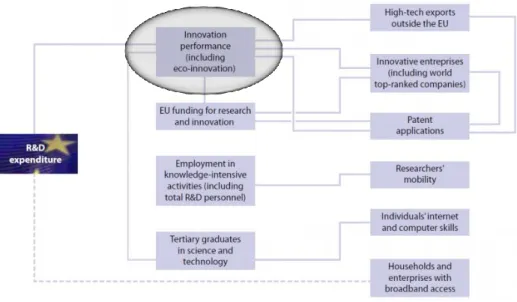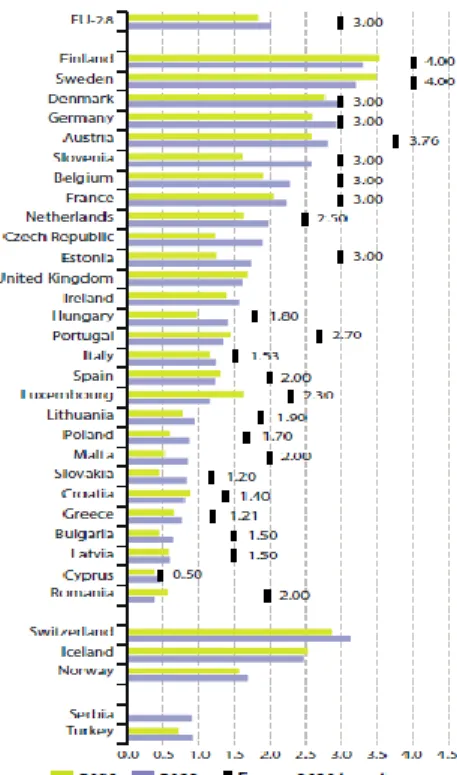Eco-innovation activities and its disclosures on sustainability
reports: an exploratory study with two samples of industrial
European companies
By,
António Pedro Martins Vieira
Master’s Dissertation in Environmental Economics and Management
Supervisors
Prof. Cristina Chaves
Prof. Gregor Radonjič
ii
Bibliographic Note
António Pedro Martins Vieira was born in Porto, Portugal on May 4th, 1992, city where he followed his studies until his graduation in 2010 from Externato Ribadouro, after studying Sciences and Technologies.
Following his interests in the environmental area, in the same year António Pedro joined the Faculty of Sciences of the University of Porto where he studied for four years attending Sciences and Technologies of the Environment bachelor. During this period, has part of his degree’s requirements, António performed an internship in Águas do Douro e Paiva, S.A in the area of Energy Efficiency and Management.
In 2014 António graduated and decided to pursue his studies in the area of the environment, but within a different scope than the scientific. Thus, to continue with his academic education António has enrolled the Master in Environmental Management and Economics developed by Faculty of Economics of the University of Porto. During his period, António spent one semester studying in Maribor, Slovenia, as part of Erasmus Program.
iii
Acknowledgments
First, I would like to thank Professor Cristina Chaves for all support and guidance throughout the development of this dissertation. Her contributions as a supervisor were fundamental for the accomplishment of the final work.
Additionally, I would like to express my tremendous gratitude to Professor GregorRadonjič for his contribution as supervisor of my thesis. Despite the distance he has demonstrated incredible dedication and commitment in the development of this dissertation and was an exceptional mentor.
I would also like to thank Miguel and Marta, for the motivation and help provided in all the moments.
At last, a word of acknowledgment to my grandmother, for her support throughout all these years.
iv
Abstract
Nowadays two trends correlated with the environment are being addressed by organizations: eco-innovation and sustainability reporting. Eco-innovation is a strategy to tackle both environmental and economic challenges, acting as a catalyst to foster sustainable economic development and green growth. In fact, as eco-innovation is recognized to be a valuable resource to achieve the objectives of Europe 2020 and to foster Europe’s economy to become more competitive and resilient, the EU is promoting eco-innovation with specific plans such as the EcoAP.
Sustainability reporting is another trend, where companies are able to provide disclosures on their economic, environmental and social performance to the public and stakeholders, reaping benefits such as enhancement of corporate reputation.
These thesis aims to evaluate if some specific companies provide disclosures on eco-innovations, through a qualitative analysis to sustainability reports of two samples of industrial European companies. The results suggest that the selected companies are disclosing the environmental benefits achieved due to the application of eco-innovative activities, but there is a general absence of the term “eco-innovation” associated to these accomplishments in their reports. However, the explanations for the improvements are present in some cases, and an indirect type of eco-innovation may be identified, from which it’s possible to categorize eco-process, product and eco-organizational innovations. The results indicate that the disclosure of “eco-innovation” term is more present in companies’ website than in their respective reports. Findings also seem to point in the direction that R&D expenditure is related with the promotion of eco-innovation.
v
Table of Contents
1. Introduction ... 1
2. Theoretical Background ... 5
2.1 Integrating environmental sustainability towards a transition to green and low-carbon economies ... 5
3. Theoretical background and main characteristics of eco-innovation ... 9
3.1 Definitions and general classification of innovation ... 9
3.2 Defining Eco-Innovation ... 10
3.2.1. Categorizing eco-innovation ... 14
3.3 Ecology Modernization Theory ... 24
3.4 Eco-Innovation for a transition to a green economy ... 25
3.5 Benefits of eco-innovation... 27
3.6 Drivers and barriers of eco-innovation ... 31
3.7 Dimensions and determinants of eco-innovation ... 34
3.7.1 Dimensions of eco-innovation ... 34
3.7.2 Determinants of Eco-Innovation ... 36
3.8 Environmental policies and regulation for enhancement of eco-innovation and competitiveness ... 40
3.9 R&D as an indicator and determinant for eco-innovation ... 42
4. The importance of eco-innovation within the European Union ... 44
4.1The program Europe 2020 ... 45
4.2 Innovation Union and the Eco-Innovation Action Plan ... 47
vi
4.4 Research and Development in the European Union... 49
4.5 Measuring Eco-Innovation performance within the EU ... 56
5. Corporate Environmental Reporting (CER) ... 59
5.1 Benefits, downsides and challenges of CER ... 60
5.2 CER in Europe ... 61
5.3 Determinants of CER in Europe ... 61
5.4 Internet as a communication channel for CER ... 62
5.5 Different report types for CER ... 62
5.5.1 Annual and Financial reports ... 63
5.5.2 Environmental reports ... 64
5.5.3 Social Reports ... 65
5.5.4 Sustainability Reports (SR) ... 65
6. Case study: Correlation between eco-innovation activities and its disclosures on the sustainability reports of European companies ... 71
6.1 Aim and Objectives of the Study ... 71
6.2 Research Methodology ... 71
6.2.1 Method of company’s selection ... 73
6.2.2 Method of data collection ... 74
6.2.3 Reports’ Analysis ... 78
6.3 Presentation of the results ... 82
6.3.1 Sample A: R&D expenditure ... 82
6.3.2 Sample B: DJSI Industry Group Leaders 2015 ... 93
6.4 Analysis of the research findings and discussion ... 106
vii 6.4.2 Discussion ... 118 7. Conclusion ... 122 8. References ... 124
viii
Table Index
Table 1-Drivers of eco-innovations according to different authors………32
Table 2-Determinants of eco-innovation………...38
Table 3-European Companies’ R&D Spending in Europe……….43
Table 4-Top 3 companies of different industrial sectors included in the 2015 EU R&D Scoreboard……… …………52
Table 5-Leading companies in R&D expenditure, worldwide and in EU………..53
Table 6-Top R&D Investing Companies by Country……….55
Table 7-Sustainability reporting categories………...69
Table 8-Types of reports analyzed for each of the selected companies………..76
Table 9- Top 10 EU R&D expenditure companies in 2014 (Sample A)………...83
Table 10- Down Jones Sustainability Index (DJSI) European Industry Group Leaders 2015 (Sample B)……….94
Table 11- -Environmental physical indicators disclosed in the reports of the European R&D expenditure leaders (Sample A)………...106
Table 12- Environmental managerial indicators disclosed in the reports of the European R&D expenditure leaders (Sample A)………. ……107
Table 13- Presence of the different terms in the reports and websites of the European R&D expenditure leaders (Sample A)………. ………108
Table 14- Types of eco-innovations identified on the sustainability report of the European R&D expenditure leaders (Sample A)………109
Table 15-Environmental physical indicators disclosed in the reports of the 2015 DJSI European Industry Leaders (Sample B)……….…………110
ix Table 16-Environmental managerial indicators disclosed in the reports of the 2015 DJSI European Industry Leaders (Sample B)……….111 Table 17-Presence of different terms in the reports and websites of the 2015 DJSI European Industry Leaders (Sample B)……….112 Table 18-Types of eco-innovations identified on the sustainability report of the 2015 DJSI European Industry Leaders (Sample B)……….113
x
Figure Index
Figure 1- Sustainable development three-dimension model………6
Figure 2- Preventive environmental technologies………..19
Figure 3- Types of Environmental Innovations………. ………...20
Figure 4-Environmental innovations and degrees of changes………...21
Figure 5- Design framework for eco-innovation in view of radical and incremental change and negative and positive impacts on the environment………..24
Figure 6-Eco-innovations as a business opportunity………. ……...30
Figure 7- Key Business Drivers for Eco-Innovation………. ……...33
Figure 8- Typology of eco-innovations………..35
Figure 9- Schematic representation of the Porter Hypothesis………..…..…41
Figure 10-Outcomes of Environmental Regulation………...41
Figure 11-EU’s Framework Programmes and respective budget progression over the years...49
Figure 12-R&D expenditure targets………...…...50
Figure 13-Gross domestic expenditures on R&D (GERD) of the EU-28 from 2002-2013………...……50
Figure 14-Gross domestic expenditures on R&D (R&D intensity) by country……….51
Figure 15-Eco-Innovation Scoreboard 2013………...58
Figure 16-Overview and relations of basic concepts and terminology related to sustainability reporting………67
xi Figure 18- Types of reports considered in the study and their share (Sample A + Sample B) ………...77 Figure 19-Number of companies analyzed by country (Sample A + Sample B)
………...78 Figure 20-Share of companies analyzed by sector (Sample A + Sample B)………...81 Figure 21-Disclosure of environmental physical indicators (Sample + Sample B)………114 Figure 22-Disclosure of Environmental Managerial Indicators (Sample A+ Sample B)...115 Figure 23-Communication of the different terms (Sample A + Sample B)………116 Figure 24-Types of eco-innovations indirectly disclosed (Sample A + Sample B)………..117
xii
List of Abbreviations
CER- Corporate Environmental Reporting CSR- Corporate Social Responsibility DJSI- Down Jones Sustainability Index EC- European Commission
EcoAP- Eco-Innovation Action Plan Eco-IS- Eco-Innovation Scoreboard EIO- Eco-Innovation Observatory EU- European Union
EMAS- Eco-Management and Audit Scheme EMS- Environmental Management System FP- Framework Program
GHG- Green House Gases GRI- Global Reporting Initiative GSK- GlaxoSmithKline
GT- Grounded Theory
IPC- Integrated Pollution Control
ISO- International Organization for Standardization IU- Innovation Union
xiii LCA- Life-cycle Assessment
R&D- Research and Development
WBCSD- World Business Council for Sustainable Development SD- Sustainable Development
SME- Small and Medium-sized Enterprise SR- Sustainability Reporting
1
1. Introduction
“The ‘environment’ is where we live; and development is what we all do in attempting to improve our lot within that abode. The two are inseparable.” (WCED,1987, p. 7).
Almost three decades after the urgency of sustainable development being explored in “Our
Common Future” it is still visible that environmental degradation continues to exist,
threatening our well-being and social cohesion (Martino & Zommers, 2007). Humans continue to exceed ecosystems capacity, over exploring earth’s natural resources and jeopardizing society’s social and economic structures (Popa et.al., 2010).
In fact, if growth patterns are not altered, the higher economic growth rates that are required to reduce poverty in most of the developing world, will keep increasing the pressure on the natural environment (Stamm et.al., 2009). Furthermore, climate change is upon us, and its environmental impact will directly affect business, society, and ecosystems. Companies that keep addressing this issues solely in a corporate social responsibility matter, rather than a business problem, and stick to a “business-as-usual” approach, will risk the greatest consequences (Porter & Reinhardt, 2007; EC, 2011).
In a negative environmental and economic scenario, the concepts of the green economy, green growth, eco-industries and eco-innovation emerge and gain relevance in order to promote a sustainable use of resources (FORA, 2010). In fact, in the eminence of big global challenges, countries can rely nowadays on eco-innovation to tackle environmental and economic priorities simultaneously (OECD et.al., 2012). Within this context, the agreement reached at COP 21 in 2015 highlights the importance of business solutions to meet global climate goals.
Eco-innovation, or green innovation as it is also referred, is one solution for the environmental degradation problems of this century, as it contributes to a decrease in energy and resource consumption patterns, while at the same time promotes a sustainable economic activity (OECD et.al., 2012). Besides eco-innovation being a useful strategy for the
2 promotion of environmental benefits, it is also linked with the competitiveness factor of firms, countries and regions. In fact, in a current scenario on which the costs related to production and waste management are escalating, the ability that the organizations have to innovate in an environmental way, is not only a solution to environment problems but also a trigger to their competitiveness power (Arundel & Kemp, 2009).
This thesis is developed in a European post-crisis economic scenario, on which the economy of the Euro Zone is recovering1. In fact, in the latest years, the economic scenario of Europe was characterized by an intense economic crisis, affecting with more relevance the southern countries. However, the repercussion was felt in the whole Euro Zone, exposing the weaknesses in Europe's economy: EU’s GDP fell 4% in 2009 and the industrial production fell to the levels of the 1990s (EC, 2010). In the words of the former President of the European Commission, José Manuel Barroso, this crisis was a wake-up call and "business-as-usual" was recognized as a strategy leading to a gradual decline. Taking this into consideration, according to the vison of the European Commission (EC), Europe needs to address collectively the long-term challenges, regain competitiveness and boost productivity in order to reach a “sustainable recovery”. Considering these issues, the EU as reacted developing plans to foster sustainable economic growth. In this way, besides the preponderant role of the renewable energies to tackle this situation, (eco)-innovation is also being addressed by governments that are placing it in the center of the economic growth agenda and also to meet sustainable development goals, trough specific plans such as the “Horizon 2020” in the European Union, and at the same time by the scientific community, that relies heavily on the R&D funding in order to find solutions for this environmental problems. Also, the “OECD
Innovation Strategy” contemplates eco-innovation needs and highlights issues that need to
be addressed by this countries’ governments, such as the need of a high-quality education, financing of R&D, support to SMEs and promotion of knowledge sharing. However, despite these efforts, there is still a gap regarding eco-innovative performance between EU Member States that needs to be tackled more efficiently. Moreover, in many developed countries
1GDP rose 0.5% in both the euro area and the EU28 during the first quarter of 2016, compared with the previous quarter (Eurostat, 2016a)
3 innovations are strongly present- however they are not being diffused ate the necessary scale or speed in the world economy. For the achievement of a healthy global environment the EU needs to involve with other partners (EC, 2011).
All this issues and challenges, on a present scenario on which both economic and environmental dimensions are under extreme pressures, underpin the motivation of this thesis that aims to study the relation between the existence of eco-innovative activities that are under several funding programmes by the EU, and its respective disclosures in the sustainability reports of European companies.
In fact, eco-innovation is a major trend that is currently being addressed by the EU through specific programmes and funding, providing incentives on innovative companies to eco-innovate. Another major trend is sustainability reporting, where the economic, social and environmental improvements of this companies are communicated to the public. This reports provide information on company’s activities and improvements in several indicators, accomplished in part by the introduction of eco-innovations.
These days it is also essential for organizations to manage properly their corporate legitimacy in order to fulfill stakeholder’s expectations about the firm’s conduct. This legitimacy can be achieved by providing transparent information about a firm’s policy and actions and the Internet can act as a management tool for its achievement by acting as a communication channel to disclose environmental information (Bolivar, 2007). In such scenario, the trend of sustainability reporting of companies has gained increased relevance in the past years and it’s set to continue in the future, as the environmental performance of an organization affects its financial health. Thus, these considerations become of major interest for stakeholders and governments (UNCTAD, 1997).
This thesis structure can be divided into two main section. The first section (Chapter 2-Chapter 5) consists in a theoretical framework that aims to clarify eco-innovation and sustainability reporting main characteristics, implications and technical aspects that are relevant to take into account as the research deepens. It is also explored the dynamics of eco-innovation in a European context, analyzing the aspects associated to its promotion such as
4 determinants and barriers. In this segment, questions such as, “What is innovation and eco-innovation?” “What is the economic context and relevance of eco-innovation nowadays?” “What are the determinants of eco-innovation?” and “What is the state of eco-innovation in the EU?” will be addressed. Literature review aims at revealing knowledge, trends, relations and gaps in order to display and organize existing work in the fields of eco-innovation, sustainability reporting and corporate environmental reporting, as well provide an overview of the current state of this topics in the EU (Hahn & Kühnen, 2013). It can be methodologically considered as content analysis which can be used quantitatively or qualitatively (Brewton & Millward, 2001).
The second part of this thesis (Chapter 6) consists in a qualitative research regarding eco-innovation and its disclosures in the sustainability reports of two samples of European industrial companies (or in the absence of such, reports that present some level of CER). The primary research question to be addressed will be: Are eco-innovations being disclosed in the sustainability reports of the selected European industrial companies?
In addition, other research questions will be taken into consideration. For example, the identification of specific environmental indicators that are communicated in these reports. Moreover, special attention will be given to terms such as “R&D expenditure”, “innovation” and “eco-innovation”, in order to evaluate whether they were being communicated in the reports or not. In addition, we will try to categorize the disclosed eco-innovation findings into eco-product, eco-process and eco-organizational innovations, in order to understand the type of eco-innovations being promoted among the selected samples of European companies.
5
2. Theoretical Background
2.1 Integrating environmental sustainability towards a transition to green
and low-carbon economies
To contextualize the importance of eco-innovation, it becomes important to mention first the concept of sustainable development, topic that is being placed at the center of discussion regarding the future of our societies and planet.
The concept of sustainable development was introduced in 1987 in the Brundtland Report as the “development that meets the needs of the present without compromising the ability of
future generations to meet their own needs.” (WCED, 1987, p. 41). This report had the main
goal to set long-term environmental strategies for achieving sustainable development, as well as promoting a cooperation between countries with different stages of economic and social development, to better address environmental challenges of the near future. Thus, the report addresses the links between development and environment and examines emerging global challenges such as population growth, food security, biodiversity and ecosystems preservation, energy, industry development and urbanization (Martino & Zommers, 2007). The report also underlines the great importance of a new era of economic growth that will be determinant to reduce the poverty levels in the developing nations, explaining that for it to take place it must be based on policies that expand the environmental resource base (WCED, 1987).
However, the challenge of how to reconcile the economic needs and environmental requirements has been identified earlier in 1972 with the Club of Rome Report and one year after with the first oil crisis that brought to light issues regarding the increasing levels of per capita material consumption and the limited resources available to meet these needs (Stamm et.al., 2009).
The sustainable development pillars rely on improvements regarding process efficiency related to energy and the environment as well the correct management of the resources and raw material. In order to assure the security of the raw materials and maintenance of the
6 environmental integrity it’s vital to accomplish the target of keeping the average global warming below 2Cº and enabling society and ecosystems to adapt to climate change(EC, 2016d). Moreover, the cost and difficulty of mitigating greenhouse gases (GHG) emissions increases every year which means that is imperative to take actions in the present. Fortunately, in the recent years there has been progress in the development of cleaner and more efficient technologies. The economic growth and energy-related emissions have always been moving in the same direction in the past, but in the recent years they are starting to decouple. In fact, 2014 was marked by an economic growth of 3% but the energy intensity of the global economy continued its declining path (IEA, 2015).
Figure 1- Sustainable development three-dimension model; Source: Parkin et.al., (2003, p. 19) In this sustainable development scenario, economic agents are required to consider the environmental dimension in their operations and organizations need to replace their traditional bottom line economic approach, with a triple bottom line view, considering the intersection of the economic, social and environmental dimensions in their decision-making process, as showed in Fig.1 (Pintér et.al., 2006). According to Ashford & Hall (2011), for sustainability to be achieved, not only incremental advances must take place, but also more systemic and disruptive changes are required, that translate into major technological, organizational and social changes.
7 Environmental sustainability concept nowadays includes measures that allow an improvement in the environmental performance and/or reduced environmental impact, such as energy efficiency and reduction of GHG emissions (Pujari, 2006). In this context, eco-product innovation has been recognized as one important strategy for the achievement of environmental sustainability, growth and a better quality of life (Dangelico & Pujari, 2010). Although the transition from the fossil based economy that characterizes our societies into a sustainable green one is the answer to the inevitable multi-dimensional problems we face, it represents a huge and complex challenge. In order to make the transition, there is a need to change the business models and re-design the regulatory framework. A decade ago there was a revolution in the way we communicate, brought by the technologies. Nowadays there is a need for another revolution, related to the management of the scarce natural resources (Bisgaard et.al., 2012). Apak & Atay (2015) explain that green technology investments will happen sooner if global green innovation networks are mobilized. Kemp (2008) refers that the President of the Club of Rome believes that in the near future the worldwide markets will have a stronger ecological dimension due to the increasing limitations of natural resources. The author also alerts for the existent gap between the current practices and the eco-markets of the future and explains that for a successful transition to take place, new technologies and service innovations are needed (Kemp, 2008). Also, Porter & Reinhardt (2007, p. 15) add that “Ultimately, though, success in a carbon constrained world will be determined not by
short-term balance sheet effects or efficiency initiatives but by innovation, management acumen, and leadership”.
Following this vison, it is possible to understand that the solutions brought by
“business-as-usual” all alone are not enough to handle the magnitude of such challenges and the
incremental improvements in resource efficiency need to gain bigger and wider dimensions. Although incremental eco-innovations are important, there is a larger need to support more disruptive ones, in order to change the system’s structures from its roots, enabling a sustainable transition (OECD et.al., 2012). As explain by Dangelico & Pujari (2010), the size of green markets is increasing and the social expectations regarding sustainability are
8 emerging, reasons why it essential for researchers to investigate green product innovation and companies to integrate sustainability issues into their product development.
9
3. Theoretical background and main characteristics of eco-innovation
3.1 Definitions and general classification of innovation
When approaching the concept of eco-innovation there’s a necessity to clearly understand first the term “innovation” (Stamm, 2013). In the literature there are several definitions of innovation provided by different authors and organizations. The OECD is one of the most reliable sources to provide a definition for this term. In fact, OECD’s “Oslo Manual”2 provides a general definition of what is an innovation, comprehending a wide range of possible innovations: “the implementation of a new or significantly improved product (good
or service), or a process, a new marketing method or a new organizational method in business practices, workplace organization or external relations” (OECD & Eurostat, 2005,
p. 46). However, there are narrower definitions for innovation, regarding if it is a product innovation or a process innovation (OECD & Eurostat, 2005). Hemmelskamp (1996) and Rennings (2000) explain that according this definition provided by the “Oslo Manual”, there is mainly a distinguish between process, products and organizational innovations.
Hemmelskamp (1996, p. 2) also define innovation as “novelties resulting in the first-time
application of newly acquired know-how, of new methods or new products as well as to novelties where no new technologies are used, but where, for example, only changes in the product design are made”. This definition generally applies also to define eco-innovation.
Innovation has become essential for the creation of wealth, employment and general societies’ development (Kemp & Andersen, 2004). In fact, for a long and sustainable growth to be achieved there is a necessity to act no only at a government level, but also at a consumer and business level on which innovation plays an essential role (Sarkar, 2013). In fact, innovation presents itself as a driver for economic growth in a macro level but also in a micro level, as it enhances business competitiveness (OECD et.al., 2012).
2 The Oslo Manual, was developed jointly by the OECD and the European Commission (Eurostat) and its third
10 Regarding innovation activities, they are defined as “all scientific, technological,
organizational, financial and commercial steps which actually, or are intended to, lead to the implementation of innovations (…) Innovation activities also include R&D that is not directly related to the development of a specific innovation.” (OECD & Eurostat, 2005, p.
18).
3.2 Defining Eco-Innovation
As explained by Rennings (2000) and OECD (2009), eco-innovation has specific and distinguish properties: it’s a type of innovation that produces a reduction of environmental impact (intended or unintended) and it is not limited to innovation in products, processes, marketing methods and organizational methods, but also includes innovation in social and institutional structures. Markusson (2001, p. 46) also adds that eco-innovations have other characteristics that single them out from other innovations: “Among other things
environmental innovations involve social awareness, draw upon knowledge from a very wide range of fields and require complementary organizational innovations”. Thus,
eco-innovation is considered to be a subset of the major concept that is eco-innovation, but with environmental promise. This means that eco-innovations, in contrast to other types of innovation, may lead to the “win-win” situations regarding the economic and environmental dimension (Horbach, 2008). The OECD clarifies that a widely shared definition of eco-innovation has not been developed yet: “An inventory of Eco-Innovation policies in OECD
countries unveils a variety of definitions across countries (and sometimes across authorities in a single country)” (OECD, 2011, p. 29).
The concept of eco-innovation is recent and has been developed over the years, and different definitions therefore exist. In fact, this concept was first developed in 1996 by Fussler & James (1996) as innovation of product and process with a commercial value, but with a less environmental impact. In 1997, Peter James, British academic and consultant, proposed to define eco-innovation as “new products and processes which provide customer and business
value but significantly decrease environmental impacts" (James, 1997, p. 53). This first
11 The term “eco-innovation” has been vastly used and developed in the latest years, manly in environmental management and policy, and different authors and organizations have been drawing different definitions. However, this term is used in diverse contexts and with different underlying connotations (Carrillo-Hermossilla et.al., 2010). In fact, the definitions provided for eco-innovation are mostly broad and so several types of innovations can be defined as eco-innovations (Falk & Ryan, 2006). Kemp & Pearson (2008) explain that the concept of eco-innovations can incorporate different definitions, distinguished by their focus on either motivation or performance. In this way, the definitions on eco-innovation founded on the literature variate depending on the context and on the type of analysis about the topic. With the same vision, Markusson (2001, p. 14) states that “environmental innovations can
be defined in two ways: firstly, by the effects of innovation on the environment and, secondly, by the intentions of the innovator to reduce the environmental impact of processes and products”.
Eco-innovations are also designated by some authors in the literature as green innovations, sustainable innovations or environmental innovations (Debref, 2012). The systemic character of environmental innovations is well emphasized by the OECD as they can involve many areas of knowledge and many different industrial sectors (Markusson, 2001). Its definition it’s close to the definition of environmental technologies: “all technologies which use is less
environmentally harmful than relevant alternatives” (DG Research, 2009, p. 2). However,
eco-innovation concept is not only limited to technologies, including also new organizational methods, products, processes and system innovation. In fact, eco-innovations can occur in any kind of economic activity, and they comprehend both environmental motivated innovations and unintended environmental motivations (DG Research, 2009). This means that the purpose of an eco-innovation is not relevant for its definition, if the result itself prove to be aligned with its concept. Thus, an innovation not meant to deliver environmental benefit in the first place, but that ends doing so, it’s an eco-innovation. In fact, the EIO defines that
“eco-innovation encompasses all changes that reduce resource use across the life-cycle, regardless of whether these changes were intended to be ‘environmental’ or not” (EIO, 2013,
12 p. 2). Carrillo-Hermossilla et.al. (2010) also explain that eco-innovations can constitute a secondary effect of other non-environmental targets, such as cost reductions.
The innovation” term is also related with the concepts of efficiency”, “industry” and “design” (Sarkar, 2013). In fact, the concepts of innovation and eco-design are intrinsically connected (Slimane et.al., 2015).
For Sarkar, eco-innovation refers to “all forms of innovation-technological and
non-technological, new products and services and new business practices – that creates the creation and development of new business opportunities and benefits the environment by preventing and reducing their impact, or by optimizing the use of natural resources” (Sarkar,
2013, p. 172). Rennings (2000, p. 322) understands eco-innovations as “all measures of
relevant actors (firms, politicians, unions, associations, churches, private households) which develop new ideas, behavior, products and processes, apply or introduce them and which contribute to a reduction of environmental burdens or to ecologically specified sustainability targets.”
Also, Kemp & Pearson (2008, p. 7) , based on the OECD definition of innovation, have purposed to define eco-innovation (in the EU-funded research project, “Measuring Eco-Innovation” (MEI)), as “the production, assimilation or exploitation of a product, production
process, service or management or business method that is novel to the organization (developing or adopting it) and which results, throughout its life cycle, in a reduction of environmental risk, pollution and other negative impacts of resources use (including energy use) compared to relevant alternatives.” This definition emphasizes results, instead of
motivations and according to it it’s not relevant whether environmental improvements achieved were the main goal or happen by accident, and it can include also economic reasons such as cost saving or increasing of market share, as the source of eco-innovations (Horbach, 2015; Horbach et.al., 2012).
The concept of eco-innovation has evolved from the traditional understanding of innovating to decrease the environmental impacts towards innovating to minimize the use of natural resources in all stages of product development (EIO, 2011). In this way, the concept of
13 resource efficiency is linked to the concept of eco-innovation. Within this vison, more recently the Eco-Innovation Observatory (EIO), the leading EU-funding initiative that collects and analysis information on eco-innovations trends, defined eco-innovation as “the
introduction of any new or significantly improved product (good or service), process, organizational change or marketing solution that reduces the use of natural resources (including materials, energy, water, and land) and decreases the release of harmful substances across the life-cycle.” (EIO, 2011, p. 2).
Most of the countries consider the application of eco-innovations mainly focusing on the environmental technologies. However, in Japan for example, the concept is wider and it’s extended as a resource to meet the society challenges and the sustainable development targets (OECD, 2009). Within this vison of eco-innovation, the social component is well integrated. A more operational approach to eco-innovation created by the UNEP and delivered in the “Eco-Innovation Manual” is the following: “Eco‐innovation is the development and
application of a business model, shaped by a new business strategy that incorporates sustainability throughout all business operations based on life cycle thinking and in cooperation with partners across the value chain. It entails a coordinated set of modifications or novel solutions to products (goods / services), processes, market approach and organizational structure which leads to a company’s enhanced performance and competitiveness.” (O’Hare et.al., 2014, p. 5).
However, a more comprehensive definition of eco-innovation is provided by the Systematic Panel on Eco-innovation, as “the creation of novel and competitively priced goods,
processes, systems, services, and procedures designed to satisfy human needs and provide a better quality of life for everyone within a life-cycle minimal use of natural resources (materials including energy and surface water) per unit output and a minimal release of toxic substances” (Reid & Miedzinski, 2008, p. 1).
In this way, this will be the definition used throughout this study because it is aligned with the concepts of resource usage, energy efficiency, competitiveness and sustainability.
14 Although there is a variety of definitions and understandings around the eco-innovation topic, according to Debref (2012) there is some major details that are recurrent: eco-innovations are based on categorizations (same principle applied of standard innovations), they always allow to reduce or to avoid environmental impacts and the market is essential for eco-innovations to take place.
3.2.1. Categorizing eco-innovation
Several classifications on innovation have been made by different authors and institutions (Arundel & Kemp, 2009). These categories can also be applied to eco-innovations (Stamm, 2013).
The Oslo Manual identifies four types of innovations (OECD & Eurostat, 2005):
Product innovations, involving improvements of goods and services or the development of new ones;
Process innovations, enabling the production of a given amount of output (goods, services) with less input;
Marketing Innovations, by establishing new marketing methods (can include changes in product design and in product promotion).3
Organizational innovations, through the implementation of new organizational methods (include new forms of management, changes in business practices, in workplace organization or in the firm’s external relations).4
However, the EIO has added two more types of innovations: social and system eco-innovations (EIO, 2012). In another approach to eco-innovation categorization, Arundel & Kemp (2009) also proposed to classify it into four groups:
3 Represent “innovations aimed at better addressing customer needs, opening up new markets, or newly
positioning a firm’s product on the market, with the objective of increasing the firm’s sales”(OECD & Eurostat, 2005, p. 49)
4 Other examples of such innovations include firm environmental statements, introduction of environmental
learning techniques, development of environmental programmes and establishment of inter-organizational networks and partnerships (Markusson, 2001)
15 Environmental technologies, eco-innovations that contribute for the reduction of the environmental impacts, including pollution control technologies and cleaner technology processes;
Organization innovation, through pollution prevention schemes and by introducing environmental management and auditing systems, such as EMAS or ISO 1400; Product and service innovation, by introducing new products and services that
deliver higher environmental benefit;
Green system innovations, alternative systems that generate less environmental impacts than the existent ones: (ex: renewables-based energy systems);
From the several categories that have been assigned to eco-innovations there are some that appear in literature more often. Thus, the following a) b) and c) present some of the most common criteria to group eco-innovations, regarding where they are applied, the type of technological change to decrease or avoid pollution they represent and the degree of change associated to them, respectively.
a) Eco-process, eco-product and eco-organizational innovations
In what concerns the boundaries of eco-innovation, they can be divided into internal and external (Cheng et.al., 2014). Regarding internal innovation, there is a tendency in the literature and in fieldwork to focus on three key innovation types: process, eco-product, and eco-organizational innovation (Horbach, 2008; Triguero et.al., 2013 in Cheng et.al., 2014).
Eco-process innovation
These type of eco-innovations are directly related to operations activities and refers to the improvement of existing production processes or the introduction of new ones to reduce environmental impact (Cheng et.al., 2014). Eco-process innovations introduction is mainly motivated to achieve environmental benefit or cost savings, but can also be driven in order to comply with market regulation.
16 Eco-product innovation
Eco-product innovation refers to the introduction of new or significantly improved products in order to satisfy market needs, and is translated into product efficiency, shorter life cycles and competition gains (Cheng et.al, 2014). Pujari (2006) explains that are few the disruption forms of eco-product innovation (e.g. wind power, hybrid car) and that most of them are of incremental nature. The author also clarifies that eco-product innovation in companies is generally driven by public policy or market pressures. Technological and managerial capabilities are the essential drivers of eco-product innovation, in respect to the supply side. Collaboration with universities or research institutes, as sources of external knowledge, also influence companies’ decision in performing eco-product innovations (Triguero et.al., 2013). Eco-organizational innovation
According to Alange et.al. (1998), “organizational innovations” covers a wide spectrum of innovations, including innovations in management practices, administrative processes or in the formal organizational structure. Triguero et.al. (2013, p. 27) defines an eco-organizational innovation as “the implementation of a new organizational method in the firm's business
practices, workplace organization or external relations addressed at distributing responsibilities and decision making amongst employees on the division of work within and between firm activities (and organizational units)”. Improvements in business performance
can be achieved by the application of eco-organizational innovations that allow the reduction of administrative, transaction and supplies costs. Workplace satisfaction can also be enhanced by these eco-innovations (Cruz et.al., 2006 in Cheng et.al., 2014).
Eco-organizational innovations are considered by many authors as the most relevant for the achievement of direct or indirect environmental benefits: “The introduction of new or
relevant changes of organizational structures (organization) is especially important for environmental innovations” (Horbach, 2008, p. 170). Normally, eco-organizational
innovations do not reduce environmental impacts directly, but by supporting the implementation of eco-products and eco-processes, they can contribute indirectly to this reduction. The introduction of new management systems and activities, that integrate not
17 only the economic dimension but also safety and environment issues, is one of the most important examples of eco-organizational innovations5. In fact, these innovations have the power to promote a transition to an integrated organizational system, allowing gains in all business components (Murphy & Gouldson, 2000). As the authors state, “(…) companies
can explore the potential for improving their environmental performance by integrating environmental concerns into their strategic as well as their operational management processes” (Murphy & Gouldson, 2000, p. 37).
Environmental management systems (EMSs), such as EMAS or ISO14001, are other concrete example of eco-organizational innovation being applied in many worldwide organizations in order to improve their environmental performance, and they have a positive influence in eco-process innovations (Triguero et.al., 2013). As the authors explain, the integration of eco-organizational innovation in firms requires government action, through well designed environmental regulations. Thus, the authors claim that environmental regulatory compliance and voluntary organizational initiatives, such as adopting an EMS, are the main sources of decision to perform environmental organization innovation. EMSs are of voluntary character and can be implemented by firms in order to foster eco-innovations. They constitute a supplement to mandatory environmental regulation and legislation (Frondel et.al., 2008). EMSs were first introduced the 90’sand are defined by Sroufe (2003, p. 426) as “a system and database which integrates procedures and processes for training of
personnel, monitoring, summarizing, and reporting of specialized environmental performance information to internal and external stakeholders of a firm.”
According to Phan & Baird (2015), EMSs comprehend internationally recognized guidelines or standards to be implemented by firms, and the International Organization for Standardization (ISO 14001) and the Eco-Management and Audit Scheme (EMAS) are examples of the most used EMSs nowadays. EMSs are a common example of organizational innovations and according to the research developed by Frondel et.al. (2008), EMS adoption is majorly correlated with an expected enhancement of corporate image.
5 Examples of eco-organizational innovations are environmental management and audit schemes, pollution
18 Considering these three main types of eco-innovations, in one hand, Klepper (1996) defends that for the best results to be achieved the correct sequence should be (eco)-product innovation development and only after (eco)-process innovations. On the other hand, Maine et.al. (2012) and Raymond & St-Pierre (2010) find that (eco)-process innovations should be the first to be developed, as they are the driving force for (eco)-product innovations.6 Other authors develop the already existent holistic view over the inter-relationship that exists between eco-process, eco-product and eco-organizational innovations and defend that a systemic approach on them should be pursued by managers as they are complementary to each other (Cheng et.al., 2014; Adner & Levinthal, 2001; Damanpour & Aravind, 2006). As a prevalent strategy for managers, Cheng et.al. (2014) suggest an investment in this three types of eco-innovations, with an initial emphasis on eco-organizational innovation.
b) Cleaner Technologies versus end-of-pipe technologies
Pollution represents not only environmental degradation but also inefficiency, and it’s consider by Porter & Linde (1995a) as a form of an economic waste. Therefore, when introducing environmental innovations is important to decide whether to modify existent technologies (to make them more energy efficient, for example) or substitute them by innovative technologies that prevent pollution in its source (Debref, 2012). Following this point of view, it’s possible to divide technological eco-innovations into two different types:
end-of-pipe technologies (pollution control technologies that prevent the direct release of
harmful substances into the environment) and cleaner production technologies (product and process integrated changes) (Frondel et.al., 2004; Rennings & Zwick, 2001; Rennings, 2000).
6 As further explain by Cheng et.al. (2014, p. 83), “process innovation often equips existing production
processes with advanced techniques which, in turn, improves the capability of adding new product features to meet the market needs”.
19
Figure 2 -Preventive environmental technologies. Source: Hohmeyer & Koschel (1995) in Rennings (1998)
Environmental technological measures can be differentiated by those belonging to curative or preventive environmental protection. Preventive measures can be further subdivided into integrated or additive protection measures (see Figure 2) (Rennings & Pfeiffer, 1999). This last measures are associated with end-of-pipe technologies (Rennings, 2000). According to Frondel et.al. (2004), these technologies aim to “curb pollution emissions by implementing
add-on measures” on the processes of production. In this way, end-of-pipe technologies
allow reducing pollution from an upstream point of view (Debref, 2012). Some examples of these technologies are incineration plants, waste water treatment plants and sound absorbers (Frondel et.al., 2004).
20
Figure 3 - Types of Environmental Innovations (Frondel et.al. 2004).
Cleaner technologies, a close concept to eco-innovation, are defined as “all modifications in
processes and products which reduce impact on the environment, as compared to the processes and products which they have substituted” (Malaman, 1996 in Markusson, 2001,
p. 14). Frondel et.al. (2004, p. 1) further clarified that these technologies “(...) reduces
resource use and/or pollution at the source by using cleaner products and production methods” and are considered superior to end-of-pipe technologies for both environmental
and economic motives. However, they also are more difficult to be implemented in the organizations systems, due to their integrated nature, reason why many companies still rely more on pollution control approaches (Murphy & Gouldson, 2000). They also represent higher economic risks in the form of substantial investments in new technologies, that might not pay off in the future (Debref, 2012). However, the initial higher investment on clean technologies is expected to pay off in the medium to long-term, as they are more economically efficient and environmentally effective (Murphy & Gouldson, 2000). In fact, ultimately clean technologies allow higher cost savings, by reducing consumption on energy and material, improving this way the process efficiency (González, 2005).
Example of cleaner production technology is the use of environmentally friendly materials and Integrated Pollution Control (IPC) technologies (Frondel et.al., 2004; Murphy &
Product Innovation
Organizational
Innovation Process Innovation
End-of-pipe
technologies
Clean Technologies (Integrated measures)
21 Gouldson, 2000). Figure 3 illustrates that both end-of-pipe technologies and clean technologies fall under the category of (eco)-process innovation (Frondel et.al, 2004). Although both of these abatement options are associated with a reduction of the environmental impacts of production, cleaner production technologies have more potential to deliver other benefits than just environmental, such as reducing costs, increase competitiveness and positive employment effects (Frondel et.al., 2004).
Figure 4-Environmental innovations and degrees of changes; Source: Debref (2012)
As showed in Fig. 4, end-of-pipe technologies are associated with incremental improvements of the original production process, as cleaner technologies imply fundamental changes in the production process (Hemmelskamp, 1996).
Nowadays is common to witness a mix of both of this types technologies, and their synergies can provide environmental benefits. The option between choosing cleaner production technologies or end-of-pipe technologies depends on the underlying environmental targets, technology options, and cost associated (Frondel et.al., 2004).
Frondel et.al. (2004) have also identified the factors that influence firm’s decision to introduce different abatement technologies: motivations, environmental policy instruments, managements tools, pressure groups and facility characteristics. The authors also claim that
22 there’s a wide assumption that end-of-pipe technologies are still the most chosen option by managers. However, some studies concluded that the rate of cleaner production innovations is increasing and it has almost exceeded the share of end-of-pipe innovations (Rennings & Zwick, 2001; Frondel et.al., 2004; Cleff & Rennings, 1999).
According to Porter & Linde (1995a), the shift from pollution control to prevention constitutes the first step companies should take in order to address more efficiently environmental problems, as it allows to avoid expensive control measures of containing and eliminating pollution.
c) Incremental, disruptive and radical eco-innovations
Eco-innovation leads to different degrees of change (EIO, 2013). In this perspective it is also possible to categorize three types of (eco)-innovations (Smith, 2009; OECD, 2011):
Incremental eco-innovation
Incremental eco-innovations represent a low degree of change. These changes are localized and consist in improvements of existing technologies, regarding its performance or input characteristics. However, normally these type of eco-innovations aren’t associated with changes in the core characteristics of the existing technology (Debref, 2012).
Such improvements are made to pre-existing products, processes, services organizational set-ups (Smith, 2009). They represent generally “quick wins” for the organization, but do not lead to a systemic change all alone.
Incremental change is the most common form of innovation being practiced by companies, and over time, if applied on a large scale, incremental innovations may generate cumulative economic impacts and thus result in substantial change (EIO, 2013).
Disruptive eco-innovation
According to Smith (2009, p. 17) This type of eco-innovations represents “change that
disrupts and replaces the functional performance of a technological regime”, and leads to
shifts in the functioning of an entire system. It represents new methods of performing existing technical functions, but not changing the overall regime (Stamm, 2013). They have the power to reconfiguring entire markets, consumer behavior and technological systems (EIO, 2013).
23 Smith (2009) provides examples of disruptive innovation such as substitution of computer-based text production for electric typewriters, or the shift from film to digital graphics. Radical (or systemic) eco-innovation
This last type of eco-innovation represents a shift in the technological regime of an economy and can lead to changes in the economy’s enabling technologies (Smith, 2009). It is also more likely to involve non-technological changes and mobilize diverse actors (OECD, 2011). Examples of such eco-innovations are the reconfiguration of product-service systems (e.g.: “cradle-to-cradle” product design) and to the development of new business models (OECD et.al., 2012). Therefore, systemic innovation “goes beyond organization boundaries and
affects directly economic issues, institutions, technologies, territorialities and our perception of environment.” (Debref, 2012, p. 8).
Systemic innovations are the responsible for major disruptive changes, whereas incremental innovations continuously advance the process of change (Schumpeter, 1934 in OECD & Eurostat, 2005). This is illustrated by Figure 5 that provides a representation between the degree of change associated to an (eco)-innovation (incremental to radical) and the respective outcomes of such change. It is possible to conclude that, first, incremental changes are associated with end-of-pipe technologies and represent small steps to achieve the desirable sustainability levels; second, radical changes in the system promote eco-effectiveness, create higher positive impacts on the environment and contribute more for the achievement of a three-dimensional sustainability model.
Nowadays, incremental innovations are the dominant form of innovation, as they don’t influence existing systems to change, and so they are of easier acceptance. These innovations have led to a relative decoupling of the economic growth and environmental impacts, because in one hand they have brought environmental gains, but on the other hand these gains have been offset by the rise in consumption patterns. In this way, for the achievement of the absolute decoupling, more radical type of innovations is needed (OECD, 2010; OECD et.al., 2012). These radical innovations have more chances to be applied by the companies that
24 integrate environmental concerns into their strategic decision making processes (Murphy & Gouldson, 2000).
Figure 5- Design framework for eco-innovation in view of radical and incremental change and negative and positive impacts on the environment; Source: Carrillo-Hermosilla et.al. (2009).
3.3 Ecology Modernization Theory
As eco-innovation topic will further be developed in this dissertation, it’s important first to identify the economic approach on which it stands the most, namely the ecology modernization theory, widely adopted to explain green economics, that supports the idea that economic and environmental benefit are positively related (Chen, 2015).
Environmental issues that emerged with the industrialization process of modern societies, have been addressed by two economic approaches throughout the years: the neo-classic environmental economics and the ecological economics. This last approach is a result of the concerns on the impacts over the environment brought by the economic growth processes and addresses the interdependence between human economics and their natural ecosystems,
25 through a policy-oriented perspective (Popa et.al., 2010). In the context of ecological economics, ecological modernization theory emerges. This theory was first developed by Joseph Huber in 2000 and constitutes a possible solution to address environmental problems resulting from industrialization, as it proposes types of regulation capable of dealing with this issues, as well as foster industry competitiveness (Murphy & Gouldson, 2000).
This theory suggests win-win situations, achieved by investments in process and/or product innovations to decrease environmental degradation and thus promoting economic gains, and can be seen as a “systematic eco-innovation theory” (Chen, 2015). Although, for this economic approach on the environment to become successful, Popa et.al. (2010) suggest that there is a need to understand the interdependence between economic and natural systems, establishing proper indicators that reflect their current status, and to develop regulatory instruments that coordinate the economic development in the direction of the sustainable development principles.
3.4 Eco-Innovation for a transition to a green economy
Briefly, green growth is the pursuit of economic development in an environmentally sustainable manner. It promotes synergies between the environmental protection and economic growth, by creating an economy on which there is investments in resource savings (Sarkar, 2013).
The United Nations Environment Programme describes a green economy as one that is “low
carbon, efficient and clean in production, but also inclusive in consumption and outcomes, based on sharing, circularity, collaboration, solidarity, resilience, opportunity, and interdependence.” (UNEP, 2015, p. 6). Sarkar further explains that this kind of economy,
aligned with the principles of sustainable development, sets a reduction of the vulnerability of socioeconomic systems to environmental changes and resources constrains. In this way, companies that follow this trajectory, are better prepared and can anticipate better future scenarios (Sarkar, 2013).
26 To promote the transition towards a green economy, by promoting sustainable production consumption systems, UNEP identifies eco-innovation investments as one key policy (UNEP, 2015). Thus, eco-innovation is being promoted nowadays by countries in order to address simultaneously job markets and tackle environmental challenges and it can create alternatives to “business-as-usual” pathway (OECD et.al., 2012). In fact, “Eco-innovation
can play a role in creating more competitive businesses, resilient markets and resource efficient societies” (EIO, 2013, p. 1).
Adding to this, The Federal Ministry for Economic Cooperation and Development states that:
“Eco-Innovation is an integral part of the successful transformation towards a green economy”, and clarifies also that both incremental and groundbreaking eco-innovations must
be developed (Stamm, 2013, p. 4). In this way, the contribution of eco-innovation towards a transition from an unsustainable macroeconomic system to a green economy is valuable and needs to be implemented by companies, supported by stakeholders and foster through policy at a local and European level (EIO, 2011). In fact, there are already many examples of firms that have integrated sustainability into their business models to become more competitive, and they face the need to manage the balance between short-term profitability and long-term sustainability (Bryson & Lombardi, 2009).
The stalemate between business and competitiveness versus environmental protection was developed by Porter & Linde (1995a). In this decade, the economic vision was still very conservative, refusing to consider the environment as a business opportunity and companies claimed that environmental protection measures brought costs that lead to loose of competitiveness. However, this paradigm has shifted throughout the years, as the authors explain that a properly designed environmental standards can trigger innovations that have the capacity to lower the total cost of a product, by increasing productivity of inputs such as energy, labor or raw materials. Thus, by innovating, companies become more resource efficient, which it’s translated into an increase in competitiveness (Porter & Linde, 1995a). In fact, although government action is crucial to set the right environment for green innovation to take place, business companies are its main driver (OECD, 2011). Promoting eco-innovation is a way of companies to go “green”. The “greening” of companies’ business
27 models is the way on which companies adjust their way of doing business, applying operational measures throughout their value chain, that improve their environmental performance. This is often achieved by switching to greener inputs and producing and selling green products and services (Sarkar, 2013).
Eco-innovation can also contribute for macro level structural changes, and for its uptake, not only governments and companies are crucial, but also the participation of the citizens, researchers and stakeholders. Also, both producer and consumer can contribute for the uptake and diffusion of eco-innovation (EIO, 2013). Following this vison, Kemp & Pearson (2008, p. 8) explain that “eco-innovation occurs in the whole economy: any company adopting a
good, service, production process management or business method with environmental benefit is an eco-innovator”. Sarkar (2013) also clarifies that eco-innovations applied to the
energy and climate sector, such as renewable technologies, have grown fast in the latest years but the promotion of other types of eco-innovation has been relatively slow.
3.5 Benefits of eco-innovation
Eco-innovation can constitute a useful tool for the success of the innovation system, renovating it, by representing not only economic factors, but also social, cultural and environmental ones (Pujari, 2006). Eco-innovation activities can be motivated by different reasons such as achieving environmental benefits or economic reasons such as cost reduction (OECD, 2009). Most of the authors decide to divide the benefits brought by eco-innovations into environmental, economic and social. The following text constitutes an attempt to summarize the principle benefits brought by eco-innovations, analyzed and developed in the literature by different authors, regarding these three dimensions, and considering also a business perspective.
28 Environmental benefits
According to Hemmelskamp (1996), environmental innovations serve to: avoid or reduce emissions caused by the production, reduce resource input, clean up environmental damage and identify and control pollution. Also, Horbach (2016) explains that eco-innovations are crucial for the climate protection since they lead to a reduction in the energy usage, contributing for a reduction of the external negative effects of economic activities. Recent projects on the topic have showed concrete proof of the ability of eco-innovations in cutting GHG emissions, reducing water and energy consumption, as well as allowing environmental savings in the order of € million (EC, 2013). The European Parliament Committee on the Environment, Public Health and Food Safety, also highlights eco-innovation potential in contributing to the shift to a resource-efficient and low-carbon economy, by an increasing usage of recycled materials, innovative production processes and quality products that present less environmental impact. However, some target actions must take place in order to put down barriers to the internationalization and commercialization of eco-innovations (Kadenbach, 2013).
Economic benefits
Economic benefits brought by eco-innovations are generally associated with cost-savings (Horbach, 2015). These economic gains are normally translated into a reduction of internal costs associated with a less consumption of materials and resources and by delivering products that are more energy and resource-efficient with a longer lifetime. Other economic benefits are avoidance of other costs, minimization of administrative expenses and reducing costs for safety (OECD et.al., 2012). Increased competitiveness, the creation of new markets for environmental products and positive employment effects are, among other, potential economic benefits associated to an eco-innovative-friendly environmental policy (Frondel et.al., 2004).
For example, in a specific eco-innovative project, “each euro of eco-innovation grant yields
a leverage factor of € 10 in revenues” (EC, 2013). Moreover, it is estimated by the EC the
annual turnover of ‘‘European eco-industries’’ at €319 billion, which corresponds to 2.5% of the EU GDP (Sarkar, 2013).
